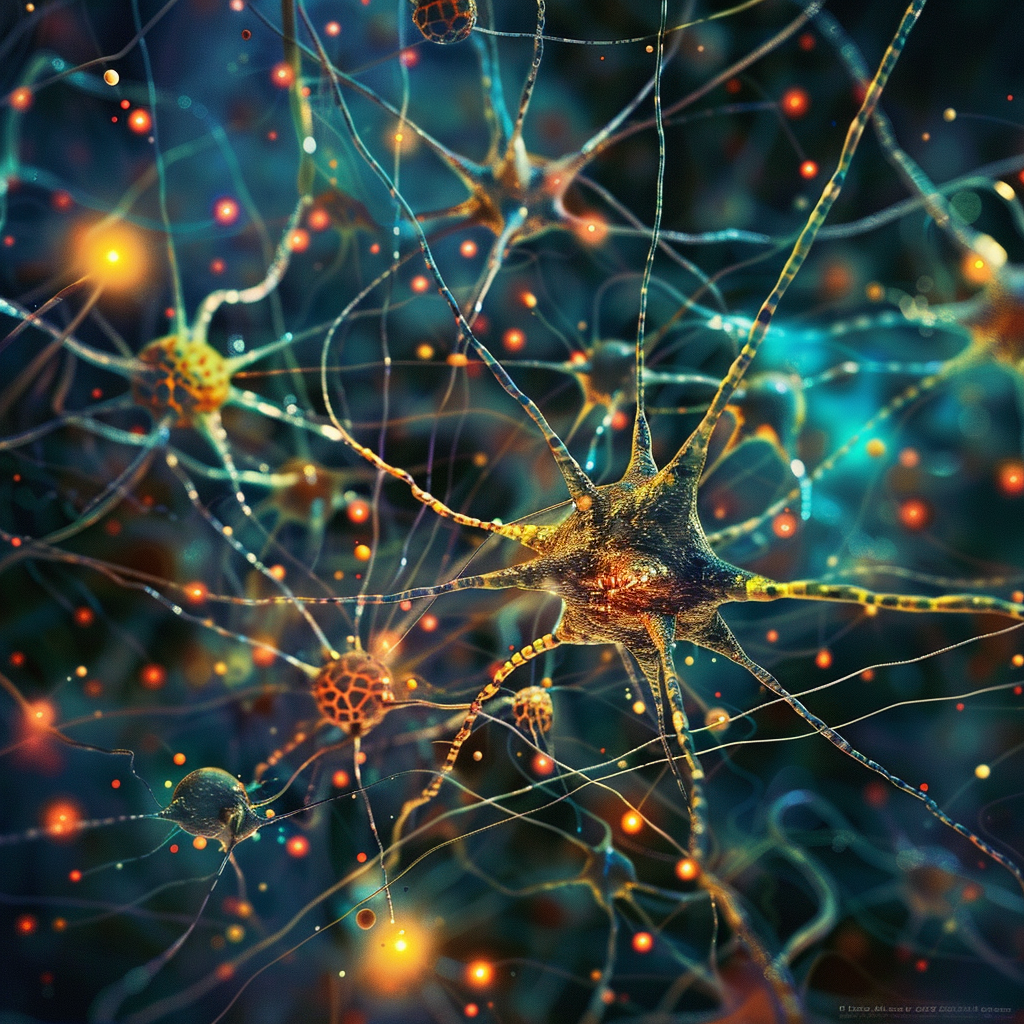5 Deep Learning and Neural Networks
Chapter Learning Objectives
- Understand and explain the concept of Deep Learning and Neural Network Architectures, and their significance in the field of Machine Learning .
- Analyze the key characteristics and applications of Deep Learning across various industries.
- Describe how Deep Learning is applied in practical scenarios such as content creation, sentiment analysis, and predictive analytics.
- Evaluate the benefits and limitations of Deep Learning in comparison to traditional machine learning approaches.
Deep Learning and Neural Network Architectures: Unleashing the Power of Complexity
In the ever-evolving landscape of Machine Learning (ML), Deep Learning stands out as a paradigm that goes beyond traditional approaches, empowering models to unravel intricate patterns, relationships, and representations within data. Central to Deep Learning is the concept of Neural Network Architectures, which emulate the complex connectivity and learning mechanisms observed in the human brain.
Deep Learning: A Paradigm Shift:
Deep Learning represents a transformative paradigm in ML, marked by the utilization of deep neural networks—models with multiple layers (or depths)—to automatically learn and extract features from data. Unlike traditional machine learning approaches, Deep Learning thrives on its ability to autonomously discern hierarchical representations, enabling it to excel in tasks ranging from image and speech recognition to natural language processing.
Key Characteristics:
 Hierarchical Feature Learning: Deep learning models have revolutionized the field of machine learning by autonomously learning hierarchical representations of data. These models are designed to capture intricate features at different levels of abstraction, which allows them to effectively understand and interpret complex patterns in the data. The hierarchical feature learning process in deep learning models involves multiple layers of interconnected artificial neurons in neural networks. Each layer in the network learns to extract and represent different features from the input data. The lower layers capture simple and local features, such as edges and textures, while the higher layers learn more complex and global features, such as shapes and objects. By learning hierarchical representations, deep learning models can automatically discover and exploit the underlying structure and patterns in the data. This enables them to achieve remarkable performance in various tasks, such as image classification, speech recognition, natural language processing, and many others.
Hierarchical Feature Learning: Deep learning models have revolutionized the field of machine learning by autonomously learning hierarchical representations of data. These models are designed to capture intricate features at different levels of abstraction, which allows them to effectively understand and interpret complex patterns in the data. The hierarchical feature learning process in deep learning models involves multiple layers of interconnected artificial neurons in neural networks. Each layer in the network learns to extract and represent different features from the input data. The lower layers capture simple and local features, such as edges and textures, while the higher layers learn more complex and global features, such as shapes and objects. By learning hierarchical representations, deep learning models can automatically discover and exploit the underlying structure and patterns in the data. This enables them to achieve remarkable performance in various tasks, such as image classification, speech recognition, natural language processing, and many others.- End-to-End Learning: End-to-End learning is a powerful concept in the field of deep learning. It refers to the ability of deep learning models to directly map inputs to outputs, without the need for manual feature engineering or intermediate steps. Traditionally, in machine learning tasks, a lot of effort is spent on designing and extracting relevant features from the input data. This process can be time-consuming and requires domain expertise. However, with end-to-end learning, deep learning models can automatically learn the relevant features from the raw data, making the overall process more efficient and less dependent on human intervention. This seamless integration of input and output mapping is particularly beneficial in complex tasks where there are multiple stages or sub-tasks involved. For example, in computer vision tasks such as object detection or image segmentation, traditional approaches would require separate modules for feature extraction, object recognition, and localization. With end-to-end learning, deep learning models can learn to perform all these tasks in a single step, leading to improved accuracy and performance.
- Versatility: One of the key advantages of Deep Learning is its ability to be applied to different fields such as computer vision, speech processing, healthcare, and finance. In the domain of computer vision, Deep Learning models are able to accurately identify objects, classify images, and even generate realistic images. Speech recognition systems have greatly improved with the use of Deep Learning algorithms, allowing for more accurate transcription and voice-controlled applications. This has led to the development of virtual assistants, voice assistants, and speech-to-text applications that have become an integral part of our daily lives. Deep Learning has also found applications in analyzing large amounts of medical data, Deep Learning models can assist in the early detection of diseases, predict patient outcomes, and even help in the development of personalized treatment plans. In finance, Deep Learning has been used for tasks such as fraud detection, stock market prediction, and algorithmic trading.
Neural Network Architectures: The Building Blocks of Intelligence:
At the core of Deep Learning are Neural Network Architectures—mathematical models inspired by the interconnected structure of neurons in the human brain. These architectures consist of layers of interconnected nodes (neurons), each layer contributing to the learning process in a unique way.
 Key Components:
Key Components:
- Input Layer: The first layer that receives the raw data or features.
- Hidden Layers: Intermediate layers between the input and output, where complex feature extraction and representation learning occur.
- Output Layer: The final layer that produces the model’s predictions or classifications.
Types of Neural Network Architectures:
- Feedforward Neural Networks (FNN): Feedforward Neural Networks (FNN) are the simplest form of neural networks, where information flows in one direction, from the input layer to the output layer. The FNN architecture consists of multiple layers of interconnected nodes, also known as neurons. The input layer of an FNN receives the initial input data, which could be numerical values or even images. Each neuron in the input layer is connected to every neuron in the subsequent hidden layers. The hidden layers, as the name suggests, are not directly accessible from the outside and serve as intermediate layers for processing the input data. Each neuron in the hidden layers receives inputs from the previous layer and applies a mathematical transformation to produce an output. This transformation is usually a weighted sum of the inputs, followed by the application of an activation function. The activation function introduces non-linearity into the network, allowing it to learn complex patterns and relationships in the data. The outputs from the hidden layers are then passed to the output layer, which produces the final output of the network. The number of neurons in the output layer depends on the type of problem being solved. For example, in a binary classification problem, there would be two output neurons representing the two possible classes. During the training phase, the FNN learns to adjust the weights and biases of its neurons in order to minimize the difference between its predicted outputs and the true outputs. This is done through a process called backpropagation, where the error is propagated backwards through the network and used to update the weights.
- Convolutional Neural Networks (CNN): Convolutional Neural Networks, are artificial neural networks that are specifically designed to process and analyze image and spatial data. They have become increasingly popular in the field of computer vision due to their ability to automatically learn and extract meaningful features from images. The key component of CNNs is the convolutional layer. In this layer, a set of learnable filters, also known as kernels, move across the image. For each position, the filter multiplies its values with the original pixel values of the image (a process called convolution), which helps the system understand certain features or patterns at that location in the image. By applying multiple filters, the network can learn to detect a wide range of patterns at different spatial locations. The convolutional layers are typically followed by pooling layers, which simplify the information coming from the convolutional layer by reducing the size but keeping the important features. Pooling helps to make the network more robust to small translations and distortions in the input data. After several convolutional and pooling layers, the network typically ends with one or more fully connected layers. These layers take the high-level features learned by the previous layers and use them to make a final decision (like identifying what object is in the image).
- Recurrent Neural Networks (RNN): Recurrent Neural Networks are a type of artificial neural network that are well-suited for handling sequential data. Unlike traditional feedforward neural networks, which process input data in a single pass, RNNs have connections that allow information to persist through time steps. This ability to retain information from previous time steps makes RNNs particularly effective for tasks such as language modeling, speech recognition, and machine translation, where the order of the input data is crucial. In an RNN, each neuron has an additional input called the “hidden state” or “memory”, which allows it to store information about previous inputs. This hidden state is updated at each time step, allowing the network to remember and utilize information from earlier in the sequence.
- Long Short-Term Memory (LSTM) and Gated Recurrent Unit (GRU): Long Short-Term Memory (LSTM) and Gated Recurrent Unit (GRU) are both variants of Recurrent Neural Networks (RNNs) that have been specifically designed to overcome the vanishing gradient problem and capture long-term dependencies in sequential data. The vanishing gradient problem refers to the issue where the gradients in the backpropagation algorithm of traditional RNNs become exponentially small as they are propagated through time. This hinders the ability of the network to learn long-term dependencies in the input sequence. LSTM and GRU architectures tackle this problem by introducing specialized memory cells and gating mechanisms. These mechanisms allow the networks to selectively retain or forget information over time, enabling them to capture long-term dependencies more effectively.
Training Deep Neural Networks: The Backpropagation Algorithm:
Training a deep neural network involves the use of the backpropagation algorithm. This iterative process adjusts the weights of connections between neurons, minimizing the difference between predicted and actual outputs. Deep Learning frameworks, such as TensorFlow and PyTorch, streamline the implementation of complex neural network architectures and the backpropagation algorithm. These frameworks provide a high-level interface for building and training deep learning models. TensorFlow, developed by Google, is widely used in both academia and industry. It offers a flexible and scalable platform for developing various machine learning applications. PyTorch, on the other hand, is an open-source deep learning framework developed by Facebook’s AI Research lab. It has gained popularity due to its dynamic computational graph, which allows for easier debugging and faster prototyping.
Both TensorFlow and PyTorch support automatic differentiation, which simplifies the process of computing gradients during backpropagation. This enables efficient optimization of neural network parameters. Additionally, these frameworks provide a wide range of pre-built layers, activation functions, and optimization algorithms, making it easier to construct complex neural network architectures.
Challenges and Considerations:
- Overfitting: Overfitting is a common challenge faced when training deep neural networks. These networks have a high capacity to capture intricate patterns and details in the data, which can lead to over-optimization and poor generalization to unseen examples. As discussed earlier, when a neural network becomes overfit, it means that it has memorized the training data too well and is unable to generalize to new, unseen examples. This can result in high training accuracy but low performance on test or validation data. To mitigate the risk of overfitting, several techniques have been developed. One such technique is dropout, which randomly drops out a fraction of the neurons during training. This helps in preventing the network from relying too heavily on specific neurons and encourages the learning of more robust and generalizable features. Regularization is another technique commonly used to combat overfitting. It adds a penalty term to the loss function during training, discouraging the network from assigning too much importance to certain weights. This helps in preventing the network from fitting noise or irrelevant patterns in the data.
- Computational Complexity: Deep Learning models, especially deep neural networks, demand significant computational resources for training. Advancements in hardware, like GPUs and TPUs, have greatly improved the computational efficiency of deep learning models. GPUs (Graphics Processing Units) are particularly well-suited for training deep neural networks due to their parallel processing capabilities. They can perform multiple calculations simultaneously, which allows for faster training times compared to traditional CPUs. Another hardware innovation, TPUs (Tensor Processing Units, are specifically designed to accelerate machine learning workloads and are even more powerful than GPUs for certain types of deep learning tasks. They excel at processing large matrices and tensors, which are fundamental to many deep learning algorithms.
Applications of Deep Learning: Unleashing Innovation Across Industries:
Deep Learning, with its capacity to discern intricate patterns and representations within data, has emerged as a transformative force across various business domains. The applications of Deep Learning extend beyond traditional machine learning methods, fostering innovation, automation, and enhanced decision-making capabilities. Here’s a glimpse into how Deep Learning is making a substantial impact in the business landscape:
Customer Engagement and Personalization:
 Recommendation Systems: Deep Learning algorithms power recommendation engines that analyze user behavior and preferences, providing personalized content, product suggestions, and advertisements.
Recommendation Systems: Deep Learning algorithms power recommendation engines that analyze user behavior and preferences, providing personalized content, product suggestions, and advertisements.- Chatbots and Virtual Assistants: Natural Language Processing (NLP) models enable the development of intelligent chatbots and virtual assistants, enhancing customer support and engagement.
Predictive Analytics and Forecasting:
- Demand Forecasting: Deep Learning models analyze historical data to predict future demand patterns, facilitating optimized inventory management and supply chain operations.
- Financial Forecasting: In finance, Deep Learning is employed for predicting stock prices, currency exchange rates, and other financial indicators.
Fraud Detection and Security:
- Anomaly Detection: Deep Learning models excel in identifying unusual patterns or outliers, enabling robust fraud detection in financial transactions, cybersecurity, and insurance claims.
- Facial Recognition: Security systems leverage deep neural networks for accurate facial recognition in access control, surveillance, and identity verification.
Healthcare and Medical Imaging:
- Disease Diagnosis: Deep Learning models analyze medical images, such as X-rays and MRIs, aiding in the early detection and diagnosis of diseases like cancer and neurological disorders.
- Drug Discovery: Deep Learning accelerates drug discovery processes by predicting potential drug candidates and understanding molecular interactions.
Supply Chain and Operations:
- Supply Chain Optimization: Deep Learning optimizes supply chain processes by predicting demand, improving logistics, and reducing operational inefficiencies.
- Quality Control: Computer vision models inspect manufacturing lines for defects, ensuring product quality and reducing defects.
Human Resources and Talent Management:
- Recruitment and Screening: Deep Learning algorithms assist in screening resumes, evaluating candidate suitability, and predicting employee performance.
- Employee Engagement: Sentiment analysis and NLP models are employed to gauge employee sentiment, enhancing HR strategies for talent retention.
Marketing and Content Generation:
- Content Creation: Deep Learning models, including language models like GPT, are utilized for generating creative content, writing articles, and automating marketing copy.
- Sentiment Analysis: Deep Learning algorithms analyze social media and customer feedback to gauge sentiment, providing insights for marketing strategies.
Financial Services and Risk Management:
 Credit Scoring: Deep Learning models enhance credit scoring by analyzing diverse data sources, leading to more accurate risk assessments.
Credit Scoring: Deep Learning models enhance credit scoring by analyzing diverse data sources, leading to more accurate risk assessments.- Fraud Prevention: In addition to detecting transactional fraud, Deep Learning models contribute to anti-money laundering efforts by analyzing patterns indicative of financial crimes.
Energy and Resource Management:
- Predictive Maintenance: Deep Learning models predict equipment failures and recommend maintenance schedules, minimizing downtime and optimizing resource utilization.
- Energy Consumption Optimization: Deep Learning assists in analyzing and optimizing energy consumption patterns, contributing to sustainable practices.
As Deep Learning continues to evolve, businesses are leveraging its capabilities to gain a competitive edge, optimize operations, and drive innovation. From enhancing customer experiences to revolutionizing traditional industries, the applications of Deep Learning in business showcase its transformative potential in reshaping how organizations operate and strategize for the future.
Chapter Summary
This chapter delves into the concept of Deep Learning and Neural Network Architectures, discussing their transformative power in the field of Machine Learning (ML). Unlike traditional ML approaches, Deep Learning leverages multiple layers of neural networks to autonomously learn and extract features from data. This unique capability enables Deep Learning models to excel in tasks such as image and speech recognition, natural language processing, and more.
Neural Network Architectures, the building blocks of intelligence, are mathematical models inspired by the human brain’s interconnected structure. These architectures consist of layers of interconnected nodes (neurons), each contributing uniquely to the learning process. The key components include the Input Layer, which receives the raw data or features.
Training deep neural networks involves the backpropagation algorithm, an iterative process that adjusts the weights of connections between neurons to minimize the error. Specialized models like Long Short-Term Memory (LSTM) and Gated Recurrent Unit (GRU), variants of Recurrent Neural Networks (RNNs), are designed to overcome the vanishing gradient problem and capture long-term dependencies in sequential data. They introduce specialized memory cells and gating mechanisms, allowing the networks to selectively retain or forget information over time.
Deep Learning has found extensive applications across various domains. For instance, in content creation, models like GPT are used to generate creative content, write articles, and automate marketing copy. Sentiment Analysis, powered by Deep Learning algorithms, analyzes social media and customer feedback to gauge sentiment, providing valuable insights for marketing strategies. In the realm of Financial Services and Risk Management, Deep Learning contributes significantly.
Deep Learning also plays a pivotal role in employee engagement, with sentiment analysis and NLP models employed to gauge employee sentiment, thereby enhancing HR strategies for talent retention. In the sphere of marketing and content generation, Deep Learning models are used for creative content generation.
In the realm of customer engagement, Deep Learning algorithms power recommendation engines that analyze user behavior and preferences, providing personalized content, product suggestions, and advertisements. Furthermore, Natural Language Processing (NLP) models enable the development of intelligent chatbots and virtual assistants, enhancing customer support and engagement.
In conclusion, Deep Learning represents a paradigm shift in ML, unleashing the power of complexity through deep neural networks. It stands out in the ever-evolving landscape of ML, empowering models to unravel intricate patterns, relationships, and representations within data.
Discussion Questions
- What is Deep Learning and how does it differ from traditional Machine Learning approaches?
- Discuss the role of Neural Network Architectures in Deep Learning. What are the key components of these architectures?
- How does Deep Learning contribute to tasks like content creation and sentiment analysis?
- What is the backpropagation algorithm and how does it contribute to the training of deep neural networks?
- Discuss the impact of Deep Learning on the Financial Services and Risk Management industry.
- How does Deep Learning contribute to employee engagement and HR strategies?
- Discuss some practical applications of Deep Learning in various business domains.
- How does Deep Learning contribute to the development of chatbots and virtual assistants?
- Discuss the concept of end-to-end learning in Deep Learning. How does it benefit tasks like object detection or image segmentation in computer vision?
- What are the potential limitations or challenges in implementing Deep Learning models in practical scenarios?

